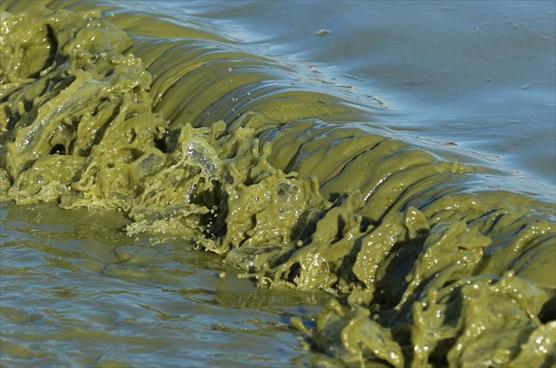Press release 2018-07-30 at 12:18
Press release of THL, Evira, Poison Information Centre and SYKE

Blue-green algae. Picture: Seppo Knuuttila SYKE
Exceptionally abundant blooms of blue-green algae, i.e. cyanobacteria, increase the risk of adverse health effects. Water containing blue-green algae must always be considered a potential health risk. If there are blue-green algae in water, it must not be consumed by people or animals, not even after boiling. Algal toxins will still be present in water for a few days after a visible bloom has disappeared.
Children and pets must not be allowed to swim in water contaminated by blue-green algae, and grown-ups should also avoid swimming. If you suspect having been exposed to contaminated water, you should wash yourself with clean water after swimming. Pets should also be washed with clean water, as they could become exposed to algal toxins by licking their fur after swimming.
Blue-green algae are particularly bad in the sauna
Water contaminated with blue-green algae must never be thrown onto the sauna stove. Exposure to contaminated water through your skin and respiration causes even more symptoms than swallowing. Exposure through the skin and respiration may also occur in water skiing and other watersports where mist is abundant.
Water contaminated with blue-green algae is not recommended for washing yourself or your dishes, or for watering edible plants.
Algal toxins do not prevent eating fish or crayfish
Crayfish and fish caught from waters contaminated with blue-green algae are edible but you should not eat fish liver. You should wash the fish and your hands carefully with clean water. High levels of liver toxins have been observed in mussels and conches in Finland, so you should avoid these.
The symptoms of poisoning are usually mild
The most common symptoms of exposure to blue-green algae are associated with the stomach: nausea, pain, diarrhoea and vomiting. Symptoms can also appear on your skin, such as rash and sting of the lips, or you may have symptoms similar to flu, such as the sniffles, headache, irritation of the eyes and high temperature. The symptoms usually start within a few hours of exposure and last for a few days, not more than a week.
Skin exposed to blue-green algae should be washed with clean water and soap. Eyes are to be rinsed with plain water only. If you have stomach-related symptoms, it is important to maintain good hydration. Painkillers or fever medication are usually not required.
If poisoning is suspected, advice can be sought from the Poison Information Centre, a general practitioner or veterinarian.
Water quality cannot be reliably measured with rapid tests
Blue-green algae produce several different toxins. Precise measurement of the neurotoxins and liver toxins produced by blue-green algae is only possible in a laboratory. The test result will only be available after several days, and the water quality may already have changed.
Rapid tests on the market can only be used to measure specific toxins, and may lead to a false sense of safety. Sensory perception of blue-green algae is enough, as symptoms suffered by people have not been linked to any specific toxin.
Among methods used for purifying household water, reverse osmosis is the only one that, when used properly, can remove algal toxins. If special circumstances dictate that water contaminated with blue-green algae has to be purified for household use, one should ensure that the reverse osmosis equipment is working properly.
Report your observations of blue-green algae
Municipal health protection authorities monitor the water quality at public beaches. Please observe notice boards and any warning signs at beaches. You may report any abundant blooms of blue-green algae to a municipal health inspector.
Observations of blue-green algae in lakes and the sea can also be reported on the Environmental Administration’s Lake and Sea Wiki service. Observations will be shown on a national map of the algae situation.
Links: